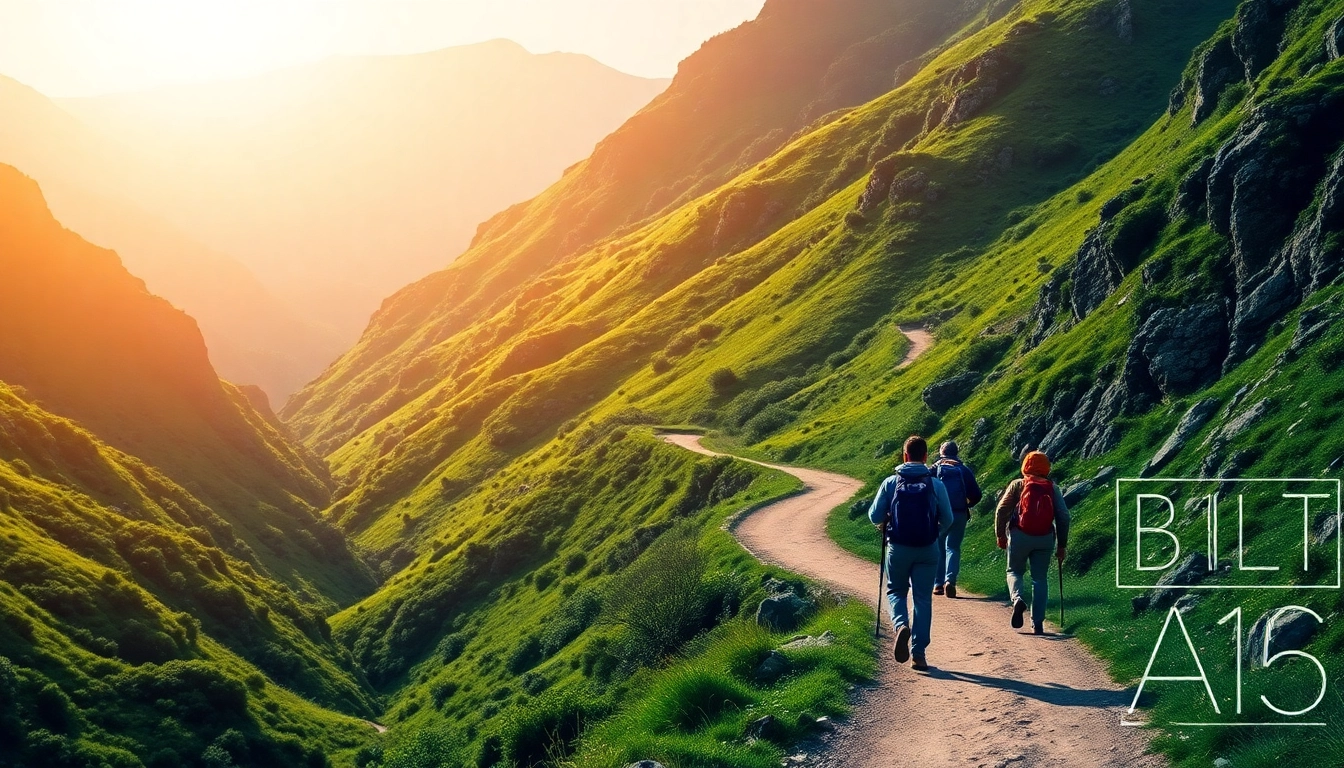Understanding the Fundamentals of Hiking and Its Multifaceted Benefits
Hiking, a timeless activity rooted in exploring the great outdoors, offers more than just a means of physical exercise; it serves as a pathway to mental clarity, environmental appreciation, and cultural connection. Whether traversing lush forests, rugged mountain trails, or scenic coastal pathways, every hike presents an opportunity to connect with nature and oneself. For enthusiasts traveling to picturesque locations like Indonesia, the experience is further enriched by the country’s diverse terrain, vibrant ecosystems, and unique cultural heritage. To truly master the art of hiking, it is essential to understand its various forms, benefits, and key considerations. You can learn more about this adventure at hike and its role in Indonesian outdoor culture.
Definition and Types of Hikes
What Is a Hike?
At its core, a hike is a long, vigorous walk often undertaken for pleasure, exercise, or exploration, typically on designated trails or natural paths. As defined by sources like Merriam-Webster, it involves traveling substantial distances through rural or wilderness areas, highlighting the physical endurance and adventure involved. Unlike casual walks on paved or well-maintained surfaces, hikes usually challenge participants with uneven terrains, elevation changes, and natural obstacles, emphasizing the importance of preparation and resilience.
Types of Hikes
Hiking activities can be broadly categorized based on terrain, purpose, and duration:
- Day Hikes: Short, manageable routes usually completed within a single day. Popular among beginners and casual outdoor enthusiasts.
- Backpacking: Multi-day hikes involving overnight camping, requiring specialized gear and strategic planning to carry supplies.
- Mountain Hiking: Trails that ascend high elevations, often demanding technical skills and awareness of altitude-related challenges.
- Urban Hikes: Exploring city parks, greenways, or natural reserves within urban settings, blending adventure with accessibility.
- Trekking: Longer, more arduous journeys through remote areas, often in overseas or less-developed regions.
In Indonesia, hiking encompasses a variety of these types, with iconic routes like Mount Rinjani, the jungles of Borneo, and the volcanic landscapes of Bali offering diverse experiences suited for all levels.
Health and Mental Benefits of Hiking
Physical Health Advantages
Engaging in regular hiking significantly boosts cardiovascular health, enhances muscular strength, and improves endurance. According to a 2020 study published in the Journal of Physiology, sustained physical activity like hiking can reduce the risk of chronic illnesses such as heart disease, diabetes, and obesity. The weight-bearing nature of hiking strengthens bones, while varied terrains promote proprioception and balance. Notably, a typical hiking session burns approximately 430 to 480 calories per hour, depending on the terrain and individual’s weight, making it an effective weight management exercise.
Mental and Emotional Well-being
Beyond physical benefits, hiking is a potent stress reliever. Time spent immersed in natural surroundings has been shown to lower cortisol levels, alleviate anxiety, and combat symptoms of depression. The phenomenon known as “nature therapy” suggests that exposure to green spaces improves mental clarity, enhances mood, and fosters overall emotional resilience. For example, a study by the University of Essex found that people who spent time in forests reported reduced stress and increased happiness. Incorporating mindfulness during hikes further amplifies these benefits, leading to improved mental health long after the trek ends.
Social and Cultural Benefits
Group hikes foster community bonding, shared experiences, and cultural exchange, especially in regions like Indonesia where local traditions intertwine with outdoor pursuits. Participating in guided hikes or joining local groups can broaden social networks and deepen appreciation of local customs, history, and ecosystems. Such interactions promote cultural understanding and preserve indigenous knowledge associated with specific trails and natural sites.
Popular Hiking Destinations in Indonesia
Mount Rinjani, Lombok
Standing at 3,726 meters, Mount Rinjani is Indonesia’s second-highest volcano and one of its most alluring hiking destinations. The challenging climb offers stunning views of calderas, lakes, and the surrounding islands. Trekkers should prepare for steep ascents, diverse vegetation zones, and unpredictable weather conditions. Rinjani’s unique volcanic landscape is a UNESCO-recognized site, attracting thousands annually seeking adventure and natural beauty.
Bromo Tengger Semeru National Park, East Java
Famous for the iconic Mount Bromo, this area delivers a surreal experience with its volcanic crater, vast savannahs, and sunrise vistas. The relatively accessible trails make it suitable for novice hikers, while still offering breathtaking scenery and photo opportunities. Visitors often combine this with other nearby mountains for a multi-day exploration.
Rainforests of Borneo and Sumatra
For those seeking jungle trekking, Indonesia’s Borneo and Sumatra are treasure troves of biodiversity. Trails through these rainforests lead to endangered orangutans, exotic flora, and indigenous communities. Guided hikes here are essential for safety and ecological conservation, offering a chance to immerse in pristine ecosystems while supporting local livelihoods.
Komodo Island and the Dragons’ Path
Though more famous for Komodo dragons, the island offers rugged coastal trails, volcanic peaks, and pristine beaches. Hiking here combines wildlife encounters with scenic exploration, making it a truly unique adventure.
Preparation and Planning for a Successful Hike
Selecting Appropriate Gear and Clothing
Proper gear is critical to ensure safety and comfort. Layered clothing adaptable to changing weather allows for temperature regulation, especially in mountainous terrains. High-quality hiking boots with good ankle support and grip prevent injuries. Additional essentials include lightweight backpacks, trekking poles, sun protection, insect repellent, and first aid kits. In Indonesia’s humid environments, quick-drying clothing and moisture-wicking fabrics optimize comfort.
Route Selection and Safety Considerations
Choosing the right trail involves assessing your fitness level, experience, and available time. Consulting detailed maps, local guides, and recent trail reports helps identify safe and suitable routes. Prioritize routes with marked trails, clear signage, and safety infrastructure. Always inform someone about your itinerary, carry a navigation device or maps, and be prepared for emergency situations.
Training and Physical Preparation
Pre-hike conditioning enhances endurance and reduces injury risk. Incorporate cardiovascular exercises such as running, cycling, or swimming. Strength training focusing on legs, core, and balance improves stability on uneven terrains. Gradual hikes with increasing difficulty accumulate fitness and familiarize you with gear handling and pace management. Hydration and nutrition training should also be part of your prep routine, ensuring optimal energy levels during the trek.
Executing Your Hike — Strategies for Success
Navigation Techniques and Trail Markings
Accurate navigation is vital. Use a combination of GPS devices, maps, and compasses. Recognize trail markers, cairns, and natural landmarks. Digital maps and offline GPS applications offer reliable guidance in remote areas. Maintain awareness of your position regularly to prevent detours or getting lost, especially in dense forests or poorly marked trails.
Managing Energy and Hydration
Eat small, frequent high-energy snacks (nuts, dried fruits, energy bars) to sustain stamina. Hydrate adequately before, during, and after hikes; in tropical climates, water loss is significant. Consider portable water purifiers or treatment tablets when refilling from natural sources. Monitoring your body’s signals for fatigue and dehydration enables timely rest breaks and prevents adverse health effects.
Wildlife and Environmental Awareness
Respect local ecosystems by adhering to Leave No Trace principles. Avoid disturbing wildlife or damaging plants. Maintain a safe distance from animals and never feed them. Be aware of potentially hazardous species such as snakes, insects, or plants. Understanding local environmental conditions, including weather patterns and trail erosion, enhances safety and sustainability.
Addressing Common Hiking Challenges
Weather Variability and Adverse Conditions
Sudden weather changes—rainstorms, temperature drops, or fog—can disrupt plans. Always check weather forecasts before departure, and carry rain gear, thermal layers, and waterproof protection. Adjust pacing and trail choices based on conditions, and avoid risky terrains during storms to prevent accidents.
Handling Unexpected Obstacles
Loose rocks, fallen trees, or trail blockages require quick decision-making. Equip yourself with versatile tools like a multi-tool or lightweight saw for minor obstructions. Remain calm and assess if hazards can be navigated safely or if an alternative route is necessary. Practice situational awareness to identify potential risks early.
Trail Safety and Emergency Response
Carry essential safety equipment, including first aid kits, whistles, and signaling devices. In remote areas, satellite phones or personal locator beacons enhance communication. Learn basic first aid and emergency procedures, such as wound care or signaling for rescue. Establish communication plans with local authorities or guides, and always hike within your skill level.
Enhancing Your Hiking Experience through Technology and Community
Utilizing Apps and GPS Devices
Technological tools greatly improve safety, navigation, and planning. Popular hiking apps offer trail maps, weather updates, and real-time tracking. Devices like GPS watches or handheld units provide accurate positioning, route recording, and altitude data. In Indonesia, offline map apps are indispensable due to inconsistent connectivity, enabling hikers to navigate confidently through remote areas.
Engaging with Hiking Groups and Communities
Joining local or online hiking groups fosters camaraderie, safety, and knowledge sharing. Community events, guided hikes, and information exchanges enrich the adventure. In regions like Indonesia, community-based ecotourism initiatives promote sustainable outdoor tourism, supporting conservation and local development.
Sharing Your Adventures and Motivating Others
Documenting hikes through photos, videos, or blogs inspires others and builds motivation. Social media platforms serve as vibrant communities where hikers exchange tips, success stories, and trail recommendations. Engaging with supportive networks encourages more individuals to explore nature responsibly and develop a lifelong passion for hiking.

